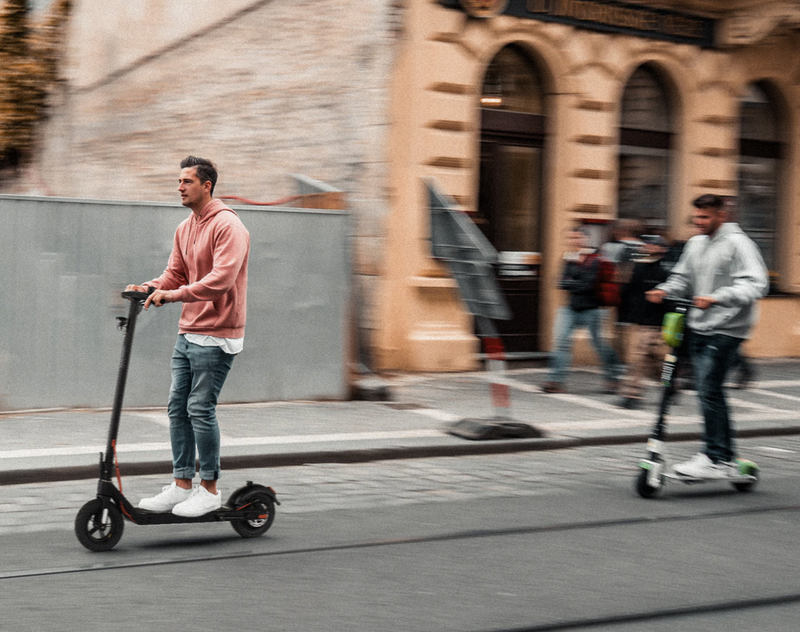Some electric scooters can get as fast as 20-30 mph at full speed, but that would be a disaster if they could not halt efficiently. This is why electric scooter brakes are important. It is the most important feature of the scooter regarding safety.
An electric scooter with a good brake set helps reduce accidents or injury. Factors like durability and performance help to determine a good set of brakes and its ability to stop abruptly even in wet conditions.
This article discusses everything you need to know about electric scooter brakes.
Part 1. 5 Different Types of Electric Scooter Brakes
Electric scooters come with different brakes depending on the model and brand. While some may come with one and some with more (preferable), here are five different types of electric scooter brakes.
There are two main categories of brake systems for the electric scooter, which are mechanical and electronic. Mechanical brakes, which are the most preferable, consist of disc, drum and foot brakes. While the disc performs best due to its 20 ft stopping distance, electronic brakes can use up to 30 feet to stop.
Disc Brakes
Disc brakes are the most efficient because of their setup, which is basically a hand lever type. When pulled, it grips the rotor with a caliper, and the brake pads activate to slow down the fast-rolling wheels. Disc brakes come in three kinds:
- Hydraulic Disc Brakes: These disc brakes use fluid lines to engage the working caliper. At the activation of the hand lever, pressure increases in the caliper, pushing a piston to grip the rotor and slow down movement. They are the best disc brake types as they give the best control.
- Semi Hydraulic Disc Brakes: This brake is like the hydraulic brake, but instead of fluid lines, it goes through a cable to the caliper. This wire goes from the lever to the caliper and moves a hydraulic piston when you pull it.
- Wire-Controlled Disc Brakes: This type often provides more friction as you feel more pull from the wire than a hydraulic press. You also activate it with the brake lever.
Let's examine the pros and cons of disc brakes in general.
Pros
- Easily adjustable and simple maintenance procedure
- Gives top-notch braking power and control (hydraulic type)
- Ultralightweight and stress-free
- Best for both wet and dry conditions
Cons
- It could require a lot of maintenance and adjustments
- Rotor damage can occur on low-quality disc brakes
- Quality diminishes with poor riding habit
- It can be expensive to maintain

Foot Brakes
For foot brakes, you can engage them by pressing down the hinged fender. The fender attaches to the rear tire to increase friction and slow the movement. You have to take your foot off the deck since it is in the rear.
Pros
- It doesn't need maintenance
- Lightweight
- Easy to use and simple design
Cons
- Foot removal from the deck is not safe
- Not as easy as hand lever brakes
- Low-quality service
- Not good in wet conditions

Drum Brakes
The drum brake is inside an enclosure that protects it from environmental damage but may cause it to overheat easily. It is a hand-activated brake and works through a cable-actuated mechanism.
Pros
- Good for wet surfaces
- Requires little maintenance
- The enclosure helps to enhance durability
- Reasonable braking performance
Cons
- Lower performance than disc
- Overheats easily
- Hard to replace due to enclosure

Electronic Brake
As the name goes, it comes into play with the push of a button. Electronic brakes function through a switch that reduces the motor terminals to produce resistance and slow down movement.
Pros
- It doesn't need any maintenance
- Easy to engage with a button press
Cons
- Susceptible to failure
- Low-quality braking

Regenerative Brakes
Just like electric brakes, regenerative brakes function through a switch that triggers the motor electrically to charge. This process produces resistance to the rotation, decelerating the scooter and halting movement.
Pros
- No maintenance needed
- Lightweight
- Charges the battery
Cons
- Susceptible to fail
- Low braking performance and quality

Part 2. Which Brake is the Most Suitable to Use in an Electric Scooter?
Mechanical brakes are easily the most suitable type for electric scooters. However, the disc brake (a type of mechanical) is the best performing, followed closely by drum brakes.
Disc brakes come with many high-value features that make them the most suitable brake system for electric systems. For starters, the brake gives more braking power on such short requests than all other types.
It is also the safest and most reliable on wet and dry surfaces, thanks to its quick-catching and strong halting prowess. Besides, they are easily adjustable and lightweight.
Most high-powered electric scooters like TurboAnt use disc brakes due to their reliability. However, TurboAnt is popular not just for disc brakes but for multiple braking systems, giving them an edge regarding safety.
Going for electric scooters with multiple braking systems is advisable as they guarantee more safety. One of the best on the market is the TurboAnt V8 Electric Scooter.
This road beast is a dual battery electric scooter with a powerful front hub and superior capabilities. The 450 W front hub gives it the required flawless riding dynamics that help you avoid traffic at a good pace. Besides, it peaks at 20 mph to provide you with a stress-less ride around the block.
The electric scooter comes with a robust frame that accommodates a weight of 125 kg to ensure safe riding for even heavyweights. It's a one-time charge joy ride as the 15 Ah dual battery system takes you a maximum range of 50 miles without power worries.
The dual braking system consisting of the disc and electronic brakes helps ensure maximum safety even at top speed. It also comes with a dual rear suspension that absorbs shocks efficiently. Moreover, its 20% climbing angle affords you the energy to glide through hilly surfaces with less effort.

Part 3. How to Use Electric Scooter Brakes Effectively
Brakes are almost useless if you don't know how to use them effectively. So, here are some ways to use electric scooter brakes effectively.
Practice Good Riding Posture
Maintaining a good riding posture puts you in the best position to ride a scooter better. It makes it safer and easier as you get optimum comfort while wheeling around town. Ensure to stand straight and maintain a balanced position on the scooter. One foot should be balanced on the deck to easily access the brakes.
Control Your Speed
Riding at a controlled speed is best as so much fast pace could lead to accidents and injuries. Moreover, riding at a very high speed can make stopping even more difficult due to increased urgency. Thus, a steady pace makes the brake even more effective. Also, endeavor to keep a foot behind the brake when descending a hill.
Use Your Feet on Uneven Ground
When riding on bumpy or uneven grounds, it is not advisable to use brakes. Instead, try to use your feet. Riding at a controlled speed can also help here as you don't need much brake to decelerate. Place your feet safely on the ground as you glide through slippery or uneven spaces.
Part 4. Tips on Electric Scooter Brakes
As far as electric scooters are concerned, there is some information that every rider should have at their fingertip. Here are some helpful tips.
1. What Is the Lifespan of an Electric Scooter Brake?
It simply depends on the time you ride the scooter, the manner of riding and the brake brand and model. However, front brakes wear faster than the rear ones when used equally. On average, your brake can go up to 200-600 miles.
2. What Makes Brakes Last Long?
Always maintain your brake regularly while avoiding frequent hard braking at high speeds. More so, endeavor to prevent disc brakes from touching degreasers as it reduces their efficiency. Clean it out, sandpaper it if needed, and close it with plastic to avoid further contact and electric scooter brake squeaking.
3. Can You Replace Electric Scooter Brakes?
Once you know how to fix electric scooter brakes, you can replace disc brakes easily because they are in an open spot with a simple setup. However, electronic and regenerative brakes are irreplaceable as they come custom-fitted with the scooter system. Drum brakes are inside a hub wheel casing which makes it difficult to change.
Conclusion
Electric scooter brakes are the feature that helps maintain a reasonable speed or halt the movement for the rider’s safety. Electric scooter brakes vary widely and function in various ways. However, this ultimate guide enlightens on its numerous aspects. Laden with high-value information, we believe that it will guide several brake-enhancement practices.





















